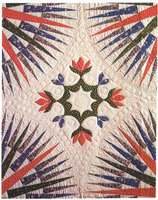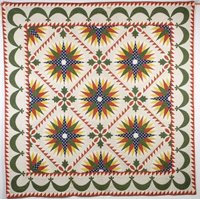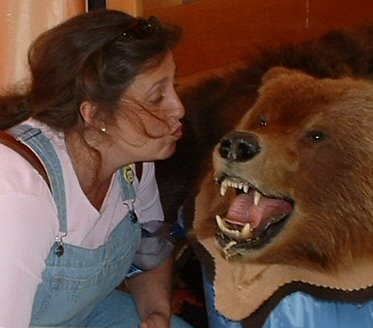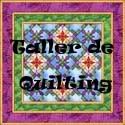Inspiration From Our Quilter Foremothers
 Here is a detail of the quilt that started my getting interested in Mariner's Compass quilts. It was made by Emeline Baker (1820-1906) in New York and it is now in the collection of the Museum of the City of New York. Emeline simply signed her work "Emeline #7". Was it her seventh quilt? Was it the seventh Mariner's Compass she made? In any case, the precission and the amazing quilting impressed me back when I first saw it and still impresses me today. I also fell in love with her choice of colors. The quilt's image is from the book New York Beauties: Quilts From The Empire State.
Here is a detail of the quilt that started my getting interested in Mariner's Compass quilts. It was made by Emeline Baker (1820-1906) in New York and it is now in the collection of the Museum of the City of New York. Emeline simply signed her work "Emeline #7". Was it her seventh quilt? Was it the seventh Mariner's Compass she made? In any case, the precission and the amazing quilting impressed me back when I first saw it and still impresses me today. I also fell in love with her choice of colors. The quilt's image is from the book New York Beauties: Quilts From The Empire State.Mariner's Compass is a circular pattern with radiating spokes. It is thought to be inspired by the compass designs of sea charts, with the most prominent points representing north, east, south and west. To be considered a Mariner's Compass, the spokes must be at least 16, often more and usually in multiples of 8. According to quilt historian, Carter Houck this pattern has a strong association with New England coastal areas. The same pattern is also known by other names: Rising Sun, Sunburst, Rising Star. The name differences could have something to do with geography. Land bound quilters might not relate to sea chart association as easily. They can be either pieced or appliqued. Lots of antique Mariner's Compass quilts have survived, being considered a "best" quilt.
 Then I came across this quilt, sold by Skinner auction house while browsing antique quilts on Google. It was made in Pennsylvania or New Jersey, ca. 1845, pieced and appliqued. Something about it made me want to make it, rather, make a smaller version of the original (107 x 107"). The timing was perfect, as I had seen the fabrics from Lancaster County, made by Marcus Brothers and I thought they'd be perfect for it.
Then I came across this quilt, sold by Skinner auction house while browsing antique quilts on Google. It was made in Pennsylvania or New Jersey, ca. 1845, pieced and appliqued. Something about it made me want to make it, rather, make a smaller version of the original (107 x 107"). The timing was perfect, as I had seen the fabrics from Lancaster County, made by Marcus Brothers and I thought they'd be perfect for it.I've modified the leaves to look a little like the ones used by Emeline in her quilt, and had to change the number of triangles in the sashing to fit the smaller proportions. I'll probably also reduce the number of swags in the border.
My deepest admiration goes to Emeline and the unknown quilter, and the countless other Mariner's Compass makers. I hope somehow they can sense that I am in awe of their work and they have been the inspiration that led me in the Mariner's Compass way.
Este es un detalle del quilt que hizo que me empezara a interesar por el patrón Mariner's Compass. Está hecho por Emeline Baker(1820-1906), de New York y pertenece a la colección del Museo de la Ciudad de New York. Emeline firmó el quilt simplemente "Emeline #7". Fue el septimo quilt que hizo? O fue el septimo Mariner's Compass? De cualquier manera, fue la precisión y el maravilloso acolchado los que me impresionaron cuando vi la foto por primera vez y once años más tarde, todavía me impresionan. También me enamoré de los colores que usó. La imagen pertenece al libro "New York Beauties: Quilts Of The Empire State".
El Mariner's Compass es un patrón circular con rayos que se proyectan desde el centro. Se piensa que puede estar inspirado en las rosas de los vientos de los mapas marítimos de los siglos XVII al XIX. Las puntas más prominentes representarían los puntos cardinales. Para considerar un bloque como Mariner's Compass, tiene que tener por lo menos 16 rayos, muchos tienen más y normalmente son en multiples de 8. De acuerdo a la historiadora de quilts Carter Houck, el nombre tiene una asociación fuerte con los estados de New England, en la costa noroeste de EEUU. El mismo patrón se conoce con otros nombres, como Sunburst, Rising Star o Rising Sun, dependiendo de las zonas en el que se hizo. Las acolchadoras de zonas sin costa, posiblemente no tuviesen la referencia mental de los mapas marítimos. Pueden ser cosidos o aplicados y se consideran un quilt "de domingo", por lo cual muchos ejemplos antiguos han sobrevivido hasta nuestros dias.
Hace unos meses buscando en imágenes de Google, encontré una foto del segundo quilt, que vendió la casa de subastas Skinner. Es de Pennsylvania o New Jersey y está fechado alrededor de la mitad del siglo XIX. Tiene patch y apliqué. Tiene un nosequé que me tentó intentar reproducirlo, aunque en un tamaño más pequeño que el original, que mide 107 x 107 pulgadas. Había visto también unas telas de Marcus Brothers que se llaman Lancaster County y pensé que serían perfectas para hacerlo.
He cambiado el diseño de las hojas aplicadas para que se parecieran un poco más al quilt de Emeline, y he tenido que reducir el número de triángulos en las tiras de separación para que me entrasen. Probablemente también reduzca el número de medias lunas del borde.
Mi más profunda admiración para Emeline, la quilter desconocida que hizo el otro quilt y las innumberables quilters que hicieron los Mariner's Compass del pasado. Espero que de alguna manera puedan sentir que su trabajo me deja sin palabras y que han sido la inspiración para que me atreviese con mi propio Mariner's.





4 Comments:
Mi más profunda admiración para tí, María, porque no solamente eres una de las culpables de que cada día intente aprender más y más, sino que haces que AME el patch.
Porque, para mí, el coser no sólo supone unir pedacitos de tela.....
Gracias María y, una vez más...... ¡¡enhorabuena!!!
:-))
De las aucciones de Skinner es uno de los que más me llamó la atención. También me había bajado la foto y la descripción como lo he hecho con algunos más.
Lo que me encantaría saber es, a cuanto finalmente fué vendido y quién lo tiene en su colección
Abrazos
Mira en:
http://www.antiquesandthearts.com/AW-2005-08-30-10-41-24p1.htm
Se vendió, no pone a quién, pero pagaron 14.100 USD incluyendo el "buyers premium".
Gracias !!!!
2.000 más de lo estimado.
Me gaurdé el enlace para chismear.
Post a Comment
<< Home